
Commuters who use Route 29 in the Fairfax Corner area harbor concerns about poor pedestrian and bicycle infrastructure, safety and traffic congestion, the results from a recent Route 29 survey suggest.
The Fairfax Department of Transportation conducted the survey from Feb. 12 to March 1 as part of an ongoing effort to make the 2.9-mile stretch between Buckleys Gate Drive and Jermantown Road more pedestrian and cyclist-friendly.
Nearly 400 people responded to the survey, about half of them saying they commute along the corridor regularly for errands, work or school. Three-quarters of those respondents drive, seven bike, two carpool, one walks, and 64 use various modes of travel.
While many respondents were content with the current state of the corridor, a majority expressed a desire for wider sidewalks and bicycle lanes, along with greater separation for those facilities from the road. The survey also identified frustrations with the roadway’s short turn lanes, which some said create long left-turn delays.

During a virtual public meeting last Tuesday (March 12), FCDOT’s Arpita Chatterjee said the newly unveiled survey findings support the department’s plans to shift away from interchanges, road widenings, and other auto-focused improvements and “explore ways to increase walking and biking along the corridor.”
“The easiest way to describe Route 29 through this corridor is kind of a mess,” Braddock District Supervisor James Walkinshaw said at the meeting. “And this study is our opportunity to develop a much better vision for this stretch of Route 29.”
Almost 20 people who attended the virtual meeting, but just one person spoke. Their comments centered on safety at the Jermantown Road intersection, and they recommended improving sidewalk lighting.
Though staff won’t present its final recommendations until summer 2024, Chatterjee said FCDOT plans to implement mitigation measures for intersections experiencing significant congestion, including Waples Mill and Shirley Gate Road.
“Overall intersection delays were over 100 seconds and side streets delays are even higher,” Chatterjee said. “But that said, we will investigate what mitigation would be possible to get the intersection of Waples Mill and Shirley Gate roads to operate more efficiently, similar or at least close to Legato Road and Monument Drive.”
The online survey will stay open until March 29, and participants can leave a recorded voicemail at 703-890-5898 using the code 3941.
There will be a second virtual meeting in the early part of this summer before staff present their final recommendations to the Board of Supervisors.

Friday night’s performance by comedian Nate Bargatze is expected to draw the largest crowd ever to EagleBank Arena on the Fairfax campus of George Mason University, according to Monumental Sports & Entertainment, which operates the arena.
Over 10,400 tickets have been sold for the event, which would break the arena’s record of 10,356 patrons for a concert by Phish on Oct. 8, 1994, Monumental said in a news release. The arena, originally known as the Patriot Center, opened in 1984.
Because of the expected large crowd, GMU and Monumental officials are advising ticketholders to allow extra travel time and to be aware of limited parking near the arena. Doors open at 7 p.m.; the show starts at 8 p.m.
Braddock District Supervisor James Walkinshaw, whose district includes the area around GMU’s Fairfax campus, warned community members on social media to expect “an increased volume of traffic” tonight.
The show begins @ 8pm, w/doors opening at 7pm Subscribe to Mason alerts (https://t.co/wi9pV74vW7) for up-to-date details on high-impact areas and alternative routes.
— Supervisor James Walkinshaw (@JRWalkinshaw) February 23, 2024
Over 14,300 fans attended Bargatze’s show at Capital One Arena in downtown Washington on Thursday night, Monumental said in a news release.
“We predicted a spike in ticket sales due to Nate Bargatze’s overwhelming popularity with fans in our region and he delivered,” said Eric Cuthbertson, general manager of EagleBank Arena. “The unique opportunity to have a show play both in D.C. and Fairfax on back-to-back nights is exciting.”
EagleBank Arena’s highest grossing event was on Sept. 2, 2023, when Mexican Latin pop group RBD generated over $1.9 million in gross ticket sales.
Bargatze is currently on his The Be Funny Tour.
This article was written by FFXnow’s news partner InsideNoVa.com and republished with permission. The headline was tweaked and Supervisor James Walkinshaw’s tweet added by FFXnow. Sign up for InsideNoVa.com’s free email subscription today.
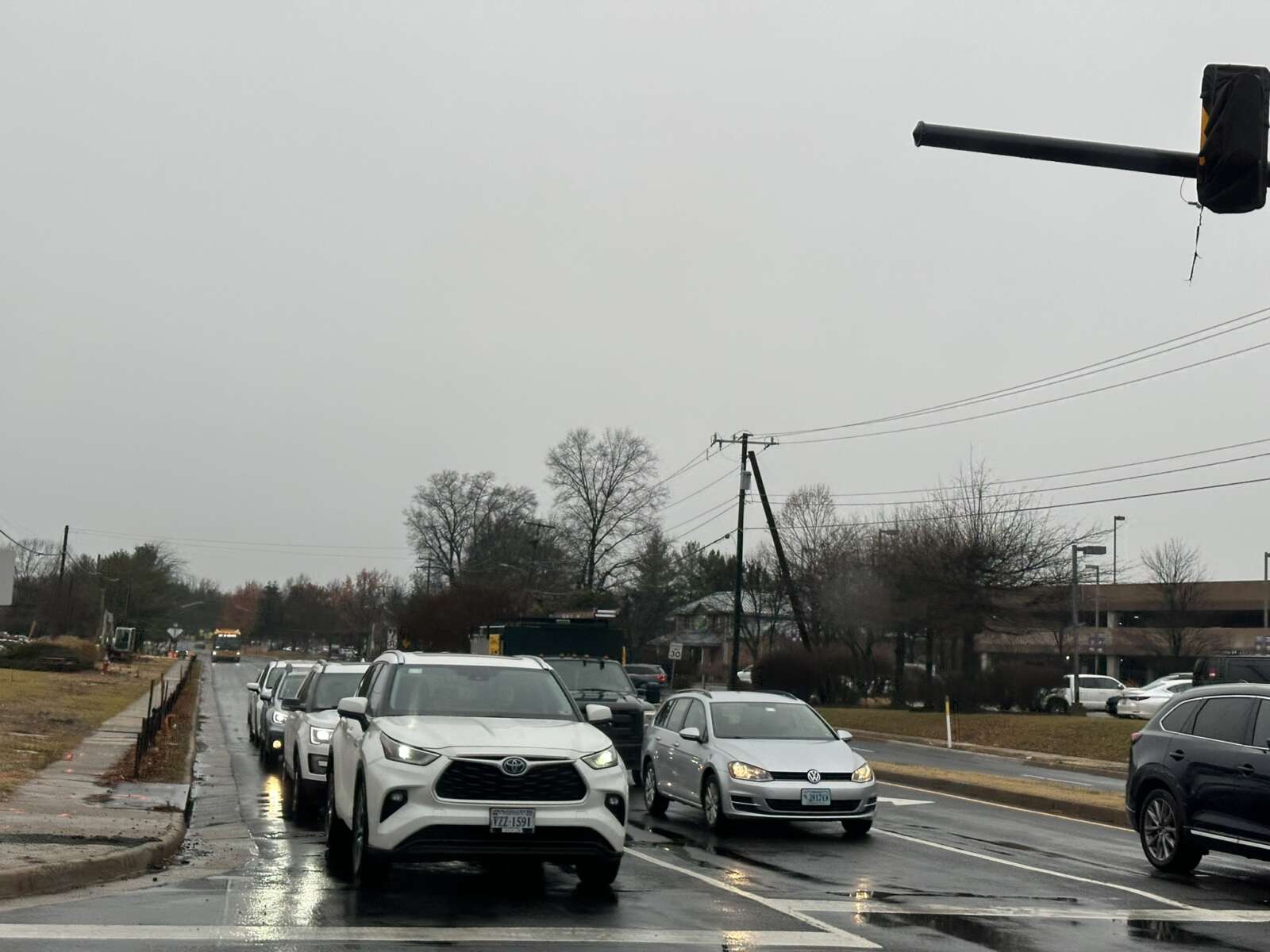
Herndon Town Council members remain concerned by cut-through traffic and spillover from development in neighboring jurisdictions following a recently released traffic study.
At a town council meeting on Feb. 13, consultant Gorove Slade reported that cut-through traffic declined overall from 2019 to 2022, but several key intersections are operating beyond their capacity loads.
The study kicked off in 2022 after former council member Sean Regan asked the town to specifically study how the Dulles Toll Road affects cut-through traffic in Herndon. The scope of the study was later expanded to the entire town, Herndon Community Development Director Lisa Gilleran said.
Still, Councilmember Donielle Scherff cautioned that more study is needed to guide meaningful policy decisions.
“It toggles the pandemic, which is just this blip we can’t all explain…I hate to say it but it almost feels like we need to continue this for two more years,” she said, noting concerns about traffic along Spring Street, Van Buren Street and some parts of Herndon Parkway.
She argued the study offers a snapshot in time and should be extended to provide more comprehensive information, particularly as more people return to work and the new Silver Line stations are used more frequently.
Overall, the study found that cut-through traffic exiting and entering the town accounted for 34% of overall traffic in 2019, dipping to 26% in 2022. The most common origin was the intersection of Sterling Road and Old Ox Road, and the most common destinations were Elden Street and Sunset Hills Road.
Overall, cut-through traffic to and from the toll road only accounted for around 8% of all cut-through traffic in 2019 and 6% in 2022.
Gorove Slade also studied capacity between April 25 and May 2 at key intersections. The consultant found that four intersections are operating beyond their set levels of service or queue lengths:
- Dranesville Road and Herndon Parkway (in the a.m., p.m. and midday)
- Herndon Parkway and Spring Street (a.m. and p.m.)
- Van Buren Street and Herndon Parkway (p.m., midday)
- Sterling Road and Crestview Drive (p.m.)
Burgeoning development at Rivana at Innovation Station in Loudoun County — which is planned for 3,700 residential units and 3.5 million square feet of office space — is expected to increase traffic. Councilmember Keven LeBlanc said the development is concerning since it’s “right on our border.”
Gilleran noted that the town expects to see traffic “increase significantly” on the Old Ox Road portal into town as a result of development.
Town Manager Bill Ashton II noted that the town is well aware of the potential impacts of neighboring development on town roads.
Ashton II said state transportation officials are not analyzing the issue from a holistic persepective and instead taking an approach that foucses mostly on Loudoun County. The town is analyzing ways to improve congestion on Sterling Road, he said.
The challenge is that the town is unable to add lanes as easily as Loudoun County — where development is newer and less dense — due to the presence of established neighborhoods, Gilleran said.
“When you come to the town line, of course, we have established neighborhoods, and so, the prospect of adding lanes is not something that the town has ever considered to be a desirable solution,” she said.

Fairfax County is continuing talks on a proposal that could allow some residents to better access their homes in areas with certain traffic restrictions.
Cut-through mitigation restrictions prohibit turns into neighborhoods from major transit corridors during rush hour. While the restrictions aim to prevent local roads from getting jammed by drivers trying to evade traffic, it can make it challenging for residents to legally access their homes on those streets.
The Fairfax County Department of Transportation is proposing a residential cut-through permit zone that would exempt residents in affected neighborhoods from the restrictions by providing permits for their vehicle. Signs that restrict turns would be changed to say “resident permit required.”
After first proposing the permit program in early 2023, FCDOT presented an update to the Fairfax County Board of Supervisors at a transportation committee meeting on Tuesday (Feb. 15).
Currently, the county is considering introducing the program in three areas with existing cut-through restrictions.
- Carolyn Drive and Nicholson Street in Lake Barcroft
- Oxford Street and Downing Street in Annandale
- Thomas Avenue in Great Falls
“There are approximately 350 addresses that are impacted, and that could initially seek impairments if this program were implemented,” county transportation planner Henri Stein McCartney said.
Another seven communities are in the process of implementing cut-through restrictions.
“If all seven projects were implemented, we would expect to have approximately 1,300 addresses county-wide that could participate in the program,” McCartney said.
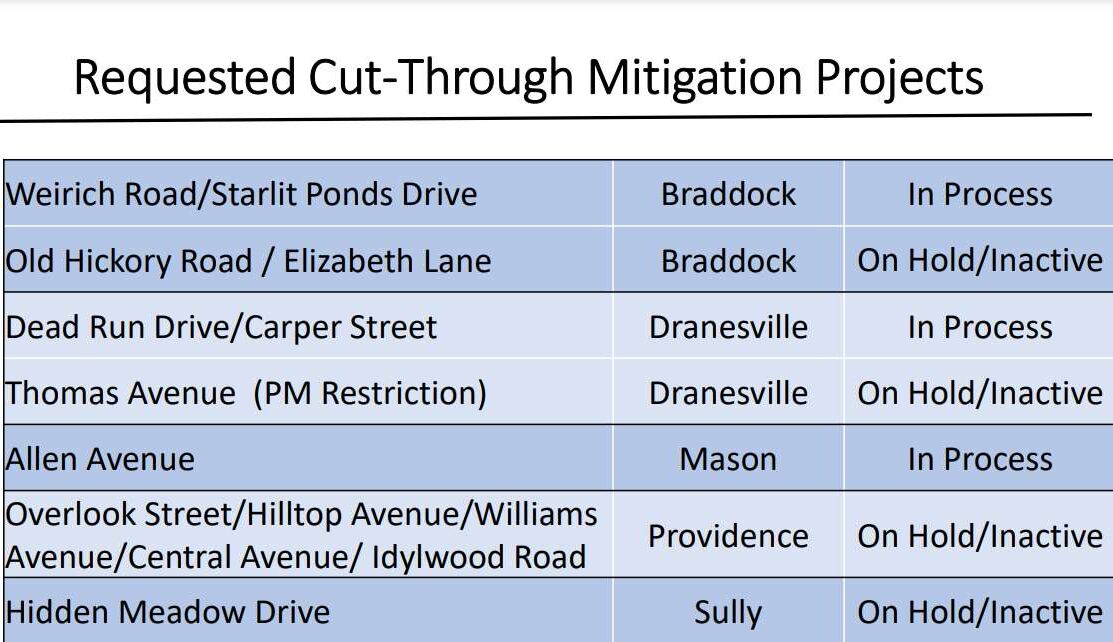
In January, the Board of Supervisors directed FCDOT to work with the Department of Tax Administration on revenue collection options for the program.
“In those conversations, tax administration recommended that we speak with the vendor that they currently have under contract for the county’s parking enforcement software,” McCartney said. “We are very early in our conversations with this vendor.”
FCDOT will return to the committee in June with additional information on using the vendor, she added.
The department is proposing a $25 permit fee for residents participating in the program. If the permits are implemented for all of the areas that have or are currently considering cut-through traffic restrictions, the county could collect an estimated $33,000 to $99,000 in gross revenue.
Chairman Jeff McKay questioned how the program would be enforced, saying it could put law enforcement in “awkward positions.”
“I don’t think we want our police checking every car that comes down the street during a certain period of time to verify residency,” he said. “I mean, to me…there’s a whole lot of problems with that.”
In its presentation, FCDOT noted that some neighboring jurisdictions, including Fairfax City, Vienna and Alexandria, have turn restrictions but don’t require permits for residents to legally access local roads. The only jurisdiction that does offer residents permits to get around turn restrictions is Falls Church City.
“Why did they decide to not offer permits and then how do they do enforcement? Because to me, that’s a really critical question here,” McKay said.
An officer with the Fairfax County Police Department conceded “it would probably be difficult to enforce,” adding that he couldn’t speak to what other localities are doing.
Hunter Mill District Supervisor Walter Alcorn asked county staff to look into automated enforcement as an option.
McCartney said she was unaware of any other jurisdictions currently using automated enforcement, but the vendor they’re working with offers it.
A proposed express car wash at Fairfax Blvd and Lion Run in Fairfax City faces an uphill battle after council members expressed concerns about its potential traffic impact.
“I’m not sure that this is the right location for this kind of business — whether it’s yours or someone else’s — given that the location is the primary access and exit for the public school system and for people south of that area,” Fairfax City Councilmember Thomas Ross said during a work session last Tuesday, Jan. 9.
Under consideration is a special-use permit that would allow the national franchise, Tommy’s Express Car Wash, to redevelop 1.15 acres at 9917 Fairfax Blvd, which has been home to the Italian restaurant The Esposito’s Fairfax since 1982.
Maria Esposito, the owner of the restaurant, told FFXnow that the restaurant currently has no intention of closing.
“We have no information yet,” she said.
The lot also has a second retail building that was built in 1978 and is currently vacant.
The applicant, D.C.-based private equity firm Olympus Pines, initially submitted a pre-application for the project in November 2021, and the Board of Architectural Review conducted a work session last month.
Designed to process up to 200 vehicles per hour, the proposed 4,553-square-foot car wash anticipates serving a “peak volume” of 50-75 cars per hour with a maximum staff of four to five, according to the city council staff report.
The site currently has a one-way entrance and one-way exit along Fairfax Blvd. The applicant has also proposed incorporating three “stacking lanes to avoid backup.”
While several council members, including Mayor Catherine Read, agreed the site should be redeveloped, there was some debate about whether the volume of vehicles served might lead to traffic issues along the route.
“Fairfax Blvd is so heavy with traffic already…There may not be a queue to get the car washed, but there may be a queue getting out of there,” Councilmember So Lim said during the work session.
Councilmember Kate Doyle Feingold pointed to other examples of businesses along Fairfax Blvd, such as Chick-fil-A, which has stacking lanes to mitigate the queuing issue.
“So, if there was an analysis where people can say, ‘Oh, I see how this could function differently,’ that might help alleviate some of those concerns,” she said.
Olympus Pines co-founder Trevor Sperry emphasized that the car wash is engineered for quick service, with vehicles in and out within minutes. He noted that other locations have washed thousands of cars daily without causing traffic disruptions.
“If people are backing up on our site, people are going to stop coming,” Sperry said during the work session.
“So, I think the main concern is, will we cause a backup on Fairfax Blvd?” he continued. “We’ve never had that happen in all of our locations, and we will provide camera data in which we served 3000 vehicles in a day without backing up the road.”
The proposal remains under review. A public hearing, which will be held before any voting takes place, has not yet been scheduled.
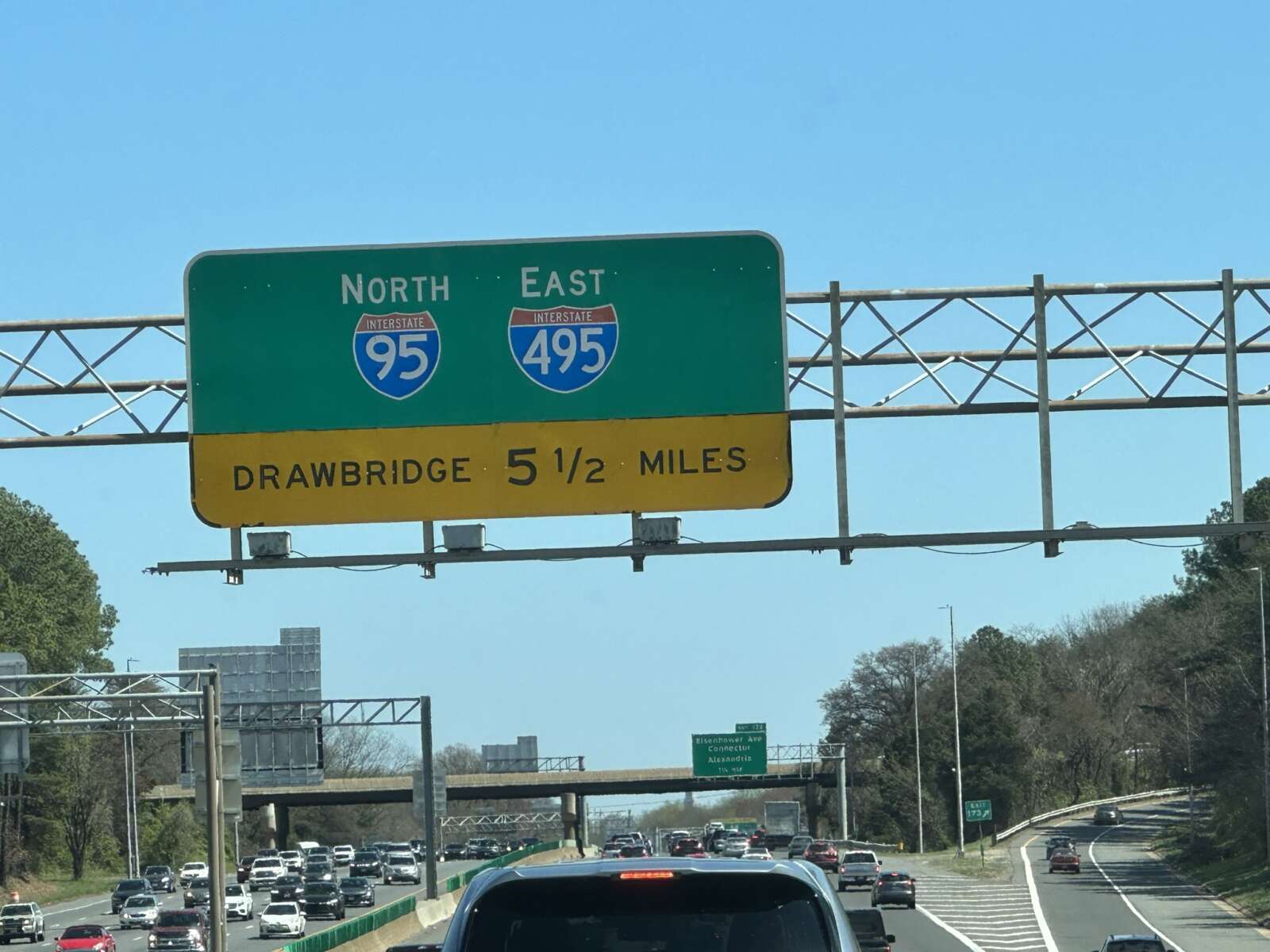
Any extension of the I-495 Express Lanes along the south side of the Capital Beltway should support additional transit options, Fairfax County leaders stressed in a recent letter to the Virginia Department of Transportation.
VDOT is currently studying options for completing the I-495 toll lanes by expanding them from the I-395/I-95 interchange in Springfield to Maryland Route 210 in Prince George’s County, an approximately 11-mile span that crosses the Woodrow Wilson Bridge in Alexandria.
At a meeting on Nov. 21, the Fairfax County Board of Supervisors approved a letter to Virginia Secretary of Transportation Sheppard Miller emphasizing the importance of accommodating transit in the project, which is intended to relieve congestion on what VDOT has said is the most heavily traveled segment of the Beltway.
“The County is appreciative that the Commonwealth is assessing solutions on the only interstate segment in Fairfax that does not have a transit benefit at this time,” the board’s letter said. “It is critical that additional travel choices are available in the Capital Beltway Corridor to move the most people as efficiently as possible in this region.”
VDOT staff presented several preliminary concepts at a public meeting on Sept. 12, including the addition of one or two general-purpose or express lanes in each direction or two reversible express lanes that would change direction with rush-hour traffic.
Staff said it has also explored adding a dedicated transit lane for buses and making adjustments that wouldn’t require new construction, such as supporting new bus routes or allowing the existing I-495 shoulders to be used as travel lanes during peak traffic periods. However, the congestion relief benefits would be limited without more space on the highway, according to the study team.
Taking a slightly more open stance than officials in Alexandria City, the Board of Supervisors didn’t comment on specific concepts, but it urged VDOT not to pursue any option that would rule out the possibility of future rail service over the Woodrow Wilson Bridge.
Opened to traffic in May 2008, the bridge was designed with a median to accommodate future transit, not with the expectation of toll lanes, Board of Supervisors Chairman Jeff McKay noted at the Nov. 21 meeting.
“From an equity standpoint, I do appreciate the fact that this is on the table, because this remains the only piece of interstate highway in Fairfax County that currently has no transit benefit whatsoever,” McKay said. “I acknowledge a failure of past efforts when projects were done to literally cut off this part of the county from the same types of transportation options that other parts of the county now have, including the communities that are sandwiched between the Springfield interchange project and the Woodrow Wilson project.”
According to the board’s letter, Fairfax County staff would support “an interim phase” without rail while Metro continues exploring how to increase capacity on its Blue, Orange and Silver lines, a study that has been underway since 2019 and could conclude by the end of this year. Read More
A vehicle fire has snarled rush-hour traffic on the Capital Beltway in Springfield.
A truck caught fire around Backlick Road just west of the Springfield Mixing Bowl, where I-495 meets I-395. The left and express southbound lanes on I-495 were closed for the fire, creating traffic backups that extended about two miles, as of 5:21 p.m., according to the Virginia Department of Transportation.
The Virginia State Police confirmed that the fire wasn’t related to a crash, and no injuries have been reported.
There was no indication of what caused the fire, Fairfax County Fire and Rescue Department spokesperson Ashley Hildebrandt told FFXnow.
As of 5:24 p.m., the fire had been extinguished, according to Hildebrandt.
Watch: This is the truck fire currently jamming the Capital Beltway (I-495S) heading from Braddock Rd to Springfield. @ffxfirerescue and @VSPPIO handling. Via @SafetyVid. @ffxnow @matthewyoung31 @CordellTraffic #safety #firefighters #traffic #vatraffic #truckfire pic.twitter.com/wJ6j2hg6lF
— Dave Statter (@STATter911) December 5, 2023
Springfield: SB 495 (Outer loop) just west of the Mixing Bowl, a vehicle fire blocks the left lanes and express lanes. One right lane gets by. Expect delays. pic.twitter.com/nuaGp3EmoT
— VDOT Northern VA (@VaDOTNOVA) December 5, 2023
Traffic camera photo via VDOT

Traffic concerns were among the top issues flagged in a survey of Town of Herndon residents.
Despite those frustrations, the survey by Priority Metric Group found high levels of satisfaction with town services and quality of life in the town.
Priority Metrics Group owner John Barrett emphasized that the results are based on a weighted sample, specifically for household income and ethnicity, in a presentation to the Herndon Town Council on July 11.
He said respondents were repeatedly instructed that the survey is intended to evaluate town services, not issues beyond the town’s purview.
Most respondents — a little over 60% — in the survey were white, while 16% of the sample was Hispanic, 15% was Asian and 7% was Black. Comparatively, the town’s population is 31% Hispanic, 41% white, 14% Asian, and 6% Black, according to the latest U.S. Census data.
The average survey participant lived in the town for 13 years, and 84% worked outside of the town. Roughly 15% of respondents plan to move from the town in the next year, largely due to the cost of living or housing.
The survey found that most respondents were very satisfied with professionalism of the police, trash and recycling services, and customer service at both the Herndon Municipal Center and the Herndon Community Center.
Satisfaction was lowest when it came to traffic flow, with just 52.3% of respondents saying they’re “satisfied” or “very satisfied responses” compared to 64.7% in a 2018 survey.
The survey also gauged thoughts on the conditions of the town’s sidewalks and streets, the overall appearance of the town, the police department’s ability to address neighborhood problems, traffic and parking code enforcement, and access to town facilities for people with disabilities.
Overall, the town continued to receive average performance ratings on six criteria, but declined on six others, including overall appearance and neighborhood safety. The most substantial decline was related to traffic.
Key issues related to the appearance of the town include challenges on Elden Street, the stalled redevelopment of downtown Herndon, and overall trash and cleanliness of the town and parks.
Still, 88% of residents are satisfied or very satisfied with quality of life in the town.
Most respondents pointed to Herndon’s small town appeal as the community’s most magnetic factor by far.
“Even though you’re kind of in the middle of this hub of activity right next to Dulles, right next to D.C…is this small community feel,” Barrett said. “People love it.”
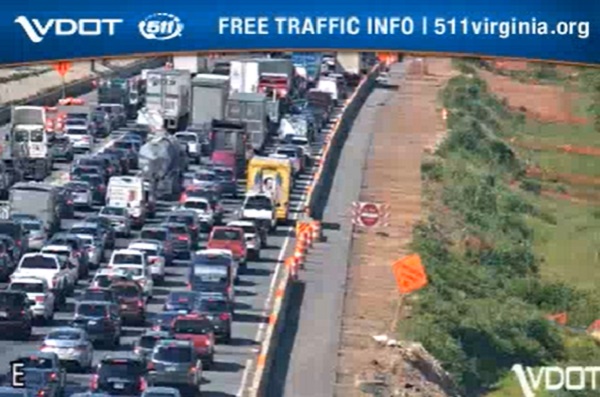
Updated at 7:45 p.m. — All lanes on I-495 have now reopened after a pair of crashes during the afternoon rush hour, according to the Virginia Department of Transportation.
Earlier: Two separate vehicle crashes have brought the Capital Beltway to a near-standstill in the McLean area just north of Tysons.
A Virginia State Police trooper told a dispatcher at 4:06 p.m. that there were “two major incidents,” both involving multiple vehicles, according to scanner traffic on Open MHz.
One crash involving a tractor-trailer occurred in the express lanes near the Lewinsville Road exit, initially blocking all northbound lanes on the Beltway (I-495), according to the Virginia Department of Transportation.
As of 4:50 p.m., one lane of traffic on the far right side of the highway was getting by.
Virginia State Police also responded to a crash in the northbound I-495 lanes near Georgetown Pike at 4:12 p.m., a spokesperson said.
“There are no reported injuries. The crash remains under investigation,” VSP said.
VDOT traffic cameras showed multiple police cars and Fairfax County Fire and Rescue vehicles near Old Dominion Drive.
On the emergency scanner, a dispatcher told responders with the Virginia State Police that a witness saw a man leaving the scene of that crash with a pocket knife.
“On I-495N Express Lanes at mile marker 44.1 in the County of Fairfax, motorists can expect major delays due to other security/police activity,” VDOT’s 511 traffic information system said at 4:31 p.m. “The north left shoulder and left lane are closed. Traffic backups are approximately 2.0 miles.”
Update McLean: 495NB past @Dulles_Toll_Rd: One right lane gets by. Pls continue to use an alternate route. https://t.co/cEne035P9h
— VDOT Northern VA (@VaDOTNOVA) July 6, 2023
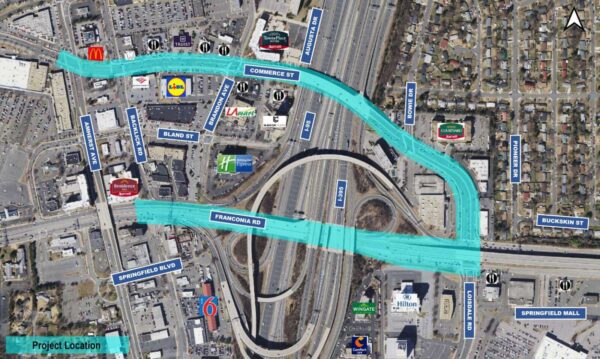
The Virginia Department of Transportation (VDOT) is asking for public input on how to reduce congestion and the number of crashes on two half-mile sections of road in Springfield.
A new survey is open through June 15, asking residents about their traveling habits and safety concerns along Franconia Road between Backlick Road and Loisdale Road. The survey also focuses on Commerce Street between Amherst Avenue and Franconia Road.
The survey marks the beginning of a STARS (Strategically Targeted Affordable Roadway Solutions) study that will help develop “proposed improvements that localities can pursue for funding,” a press release says.
Those two sections of roads, particularly Franconia Road, are of concern because they often have traffic congestion due to the nearby I-95 interchange. There’s also a high number of crashes, according to VDOT.
That half-mile section of Franconia Road averages about 69,000 vehicles a day and has had 162 crashes between January 2015 and October 2022, per a VDOT presentation. That includes at least one fatal crash and several that resulted in severe injuries.
The portion of Commerce Street in the study has much less volume, with only about 19,000 vehicles every day. But there have been even more crashes along the road during that same time period.
A large number of the 171 crashes have resulted in property damage only, but several did lead to severe injury.
VDOT is looking into a number of improvements along those roads focused on safety, the presentation notes.
That includes “innovative intersections” that have different shapes or traffic flow patterns. It could also mean adding Rectangular Rapid Flashing Beacons, high-visibility crosswalks and improved bicycle facilities, including better bicycle lane transitions and pavement markings.
What exactly will be done will, at least partially, depend on the results of the public survey, VDOT said.
In the questionnaire, respondents are asked to rank their top concerns, with traffic congestion, pedestrian safety, public transit access, and speeding among the options listed. They are also asked when they typically traveled along those roads, by what method of transportation, and when they typically experience congestion.
The survey “will be used to help develop potential safety and operational alternatives that will be evaluated and presented during the second round of public involvement scheduled for this winter,” the project website reads.
The study is set to be completed in spring 2024. No construction timeline has been set as of yet, per the press release.

